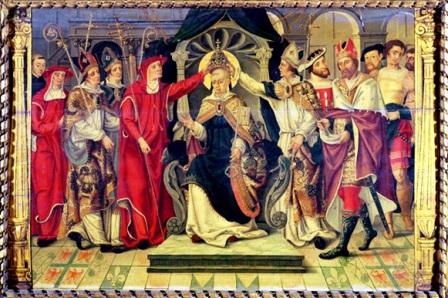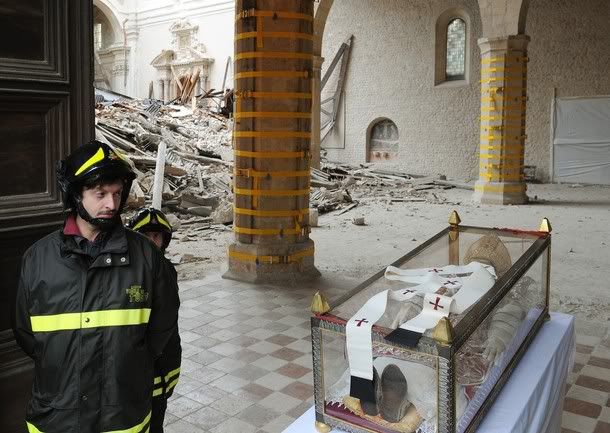A Pope in hell?

Today is the feast of St. Peter Celestine, Pope Celestine V, who famously resigned the papacy.
One of the fascinating people in our Catholic family history.
Pietro da Morrone, born c. 1215, in the Molise area of central Italy, came from a family of peasants. He entered a Benedictine monastery and later became a hermit. Peter eventually guided a community of hermits modeled along the lines of the Cistercian Benedictine rule. He was well-known for his holiness and his acclaimed ability to heal.
With the death of Nicholas IV, the see of Peter was vacant for three years. Pietro was eventually elected “by inspiration” in 1294. He took the name Celestine.
 Celestine came out of the blocks with a strong spiritual program. He created 12 cardinals, the number of the apostles, including 5 monks. Celestine was inspired by the musings of Joachim de Fiore. Celestine probably wanted to ring in a new age of the Spirit, with a strong monastic dimension, in preparation for the end times.
Celestine came out of the blocks with a strong spiritual program. He created 12 cardinals, the number of the apostles, including 5 monks. Celestine was inspired by the musings of Joachim de Fiore. Celestine probably wanted to ring in a new age of the Spirit, with a strong monastic dimension, in preparation for the end times.
In a loose way, perhaps we can see today the rise of “movements” and some of the charismatic elements of these movements – as we still emerge from the horror of the 20th century and battle the dictatorship of relativism, as being part of a pattern that repeats itself through our history after the Ascension of the Lord, the end times. Every generation has sensed itself to be in the end times. But I digress.
 Poor Pope Celestine couldn’t hold it all together. He abdicated on 13 December 1294 after only 5 months as Pope. The cardinals elected Benedict Caetani, who took the name Boniface… Boniface VIII.
Poor Pope Celestine couldn’t hold it all together. He abdicated on 13 December 1294 after only 5 months as Pope. The cardinals elected Benedict Caetani, who took the name Boniface… Boniface VIII.
The former Pope-monk but once-again-Peter fled Rome and went to his hermitage back in the hills of central Italy and Apulia. He tried to get out of Italy to Greece, but he was apprehended in June 1295 and brought to Boniface. Boniface imprisoned him. Peter Celestine died a year later on 19 May 1296 and was buried in L’Aqulia.
He was canonized in 1313. He was removed from the universal calendar of the Roman Church in 1969, but he is still venerated in the Abruzzi area of Italy. The church in which he was interred was damaged in the earthquake that rocked central Italy some time ago.
Benedict XVI visited the church. More on that, below.
Dante, in his Divine Comedy, in Inferno 3, places in hell someone whom we think may be Peter Celestine V. Dante calls him “the shade of him who in his cowardice made the great refusal”. “The great refusal” being the rejection of the highest office to which one might ascend in this world, with all the duties and responsibilities and implications for the bonds of society that that office carries.

Remember that the Divine Comedy is about, among other things, the interrelationship of the secular and the sacred. Dante was writing political theory in the Divine Comedy. His Hell is constructed to reflect the ways in which people harm no just themselves, but also the bonds of society. Dante would have hated Peter Celestine’s abdication also because he opened the way for Dante’s great enemy Boniface VIII, whom he detested.
If you have never read the Divine Comedy, you should. You could start with Esolen (Part 1, Inferno HERE) or perhaps with Dorothy Sayer’s fine version (Part 1, Inferno, HERE). There are many renderings to choose from.
When Pope Benedict visited the tomb of Pope Celestine he left his palium there, that first one he used, the longer paleo-palium.

An interesting gesture. O, my prophetic soul.


From the 2005 Martyrologium Romanum:
6. Ad Castrum Fumorense prop Alatrium in Latio, natalis sancti Petri Caelestini, qui, cum vitam eremeticam in Aprutio ageret, fama sanctitatis et miraculorum clarus, octogenarius Romanus Pontifex electus est, assumpto nomine Caelestini Quinti, sed eodem anno munere se abdicavit et solitudinem recedere maluit.
